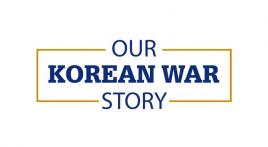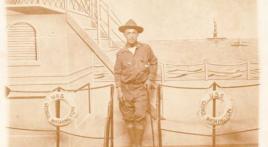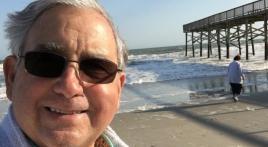Return to the USS Cassin Young
Written by Lee Rogers
Seventy-one years after serving on the ship, my father, Courtenay Rogers, returned to the USS Cassin Young in June 2016. He had not set foot aboard the ship since serving on the ship in the spring of 1945, in the Pacific Ocean, during World War II.
The Cassin Young is now part of the Naval Museum in Charlestown, Mass., in the same location as the USS Constitution, overlooking Boston Harbor. The National Park Service rangers gave him a special tour of the vessel, and were extremely welcoming and hospitable. The rangers estimated that less than 10 veterans who served on the Cassin Young are still alive.
The Cassin Young was a vital part of the Okinawa campaign, which lasted almost 3 months and was the last and biggest of the Pacific island battles of World War II. The Okinawa campaign involved the 287,000 troops of the U.S. 10th Army against 130,000 soldiers of the Japanese 32nd Army. By the end of the campaign, Japan had lost more than 77,000 soldiers and the Allies had suffered more than 65,000 casualties—with 14,000 dead.
Courtenay was a fighter director officer aboard the ship, and worked in the radar station as part of the ‘fighter operation team.’ He served in this capacity on the Cassin Young, and on three other destroyers during the war, the USS Bennion, USS Pritchett and USS John A. Bole. The Cassin Young is a Fletcher-class destroyer, and was part of Task Force 58, assigned primarily to anti-aircraft picket duties. He recalls that “picket ships” such as the Cassin Young were set around the perimeter or edge of large groups of ships, with the specific and primary purpose of detecting Japanese kamikaze planes as they approached.
During the campaign the Cassin Young had several noteworthy incidents. At the onset of the campaign she acted as a screen to larger warships as they shelled the island. She also rescued survivors from two cargo ships that had been sunk in the area. This was part of an attack on one day in which over 700 kamikazes attacked the radar stations, sinking three ships and damaging eight others, with heavy casualties. Courtenay recalls, “It was not unusual for us to be at general quarters for 24-36 hours at a time. Sometimes we had as many as eight planes attacking us at once. The only reason we survived was because of our outstanding gun crew and combat air patrol.” On April 12, 1945, the crew shot down five enemy aircraft before one of the Japanese planes crashed into the foremast and exploded, killing one man. On July 28 she shot down two enemy planes and helped pick up men from another sunken vessel. The following day she faced another airborne attack from a specially equipped attack plane, which struck the ship on the side, killing 22 and injuring 45. Fire broke out on the ship but the crew quickly came to the rescue and put out the flames in only 20 minutes. He recalls “that the mistake that the Japanese made at Okinawa was that they primarily attacked the radar picket stations, instead of passing them by and going directly towards the fleet where the supply ships and landing craft were. They came right at us (the picket ships) day after day after day. “
Courtenay remembers another major event that impacted the Cassin Young and many other ships - sailing through a huge typhoon, known as ‘Typhoon Viper’ in June 1945. Part of the group, including the carriers USS Hornet and USS Bennington, were operating east of Okinawa when a tropical depression formed near the Philippines. But communication delays and inaccurate information kept the 3rd Fleet from knowing that a powerful and compact typhoon was heading directly for them. Winds that reached 120 MPH made the seas quite rough. Courtenay recalls that ”waves were 70-80 feet high, and what saved us was seamanship. I remember being on the bridge and seeing four quartermasters lashed to the wheel, trying to keep the bow into the 80-foot swells. It would have been ironic to survive three months of kamikaze attacks and then drown in a storm.“ During the storm the USS Pittsburgh broke apart, and many other ships were damaged.
After the storm the Cassin Young helped in the effort to support the Marines and Army forces in the process of retaking Okinawa. He remembers: “from the naval standpoint you had to admire the guts of those Marine and Army troops. In the Navy you have a bunk, plus food and shelter. I had the greatest admiration for the Marines and the Army.” In July 1945 Courtenay was transferred to the USS Pritchett, which was attacked on the 29th. Recalls Courtenay: “I was the duty officer in the Combat Information Center (CIC), when the radar man said that he had picked up a flight of birds. We tracked them and they were doing 90 knots, definitely not birds. It was a bitter pill that the attacking 12 aircraft were old twin float biplanes made of fabric and wood, against which proximity fuses were not effective. One hit the USS Callaghan, sinking it.“ The Pritchett, picking up men from the sunken ship, was also hit during this attack.
Naval casualties reached 10,000 during Okinawa, the most in U.S. naval history. There were over 2,000 kamikaze attack between April and July 1945, mostly against the “picket ships”. The attacks sank 15 destroyers while damaging 100 more. One of the ships that Courtenay served on, the USS Bennion, received the Presidential Unit Citation for service during Okinawa.
After the war Courtenay continued his education with the help of the GI Bill, and worked at Union Carbide Corp. for 38 years. After residing in Connecticut for many years, he now lives in Florida with his wife, Shirley.
Returning to the ship 71 years later was an extremely gratifying experience for my father, and for our entire family. We gathered at the Charlestown Navy Yard on a beautiful sunny late-July afternoon. The rangers from the National Park Service were tremendously gracious and incredibly helpful in guiding Courtenay back through the ship, into the radar station areas. There was a celebration for the USS Constitution that day as well, during which Courtenay was recognized for his service in the Navy, and on the Cassin Young.




